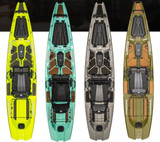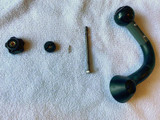How does a Hydrofoil board work?
Why settle for merely skimming the water when you can actually fly over it? Hydrofoil boards are redefining the boundaries of water sports. Unlike conventional boards that plow through the water, hydrofoil boards give you the sensation of levitating above it.
When combined with windsurfing sails, these boards not only deliver unmatched speed but also make for an exhilarating experience that's hard to replicate. It's not just about the thrill, though; hydrofoiling is a highly efficient method of gliding across the water, reducing drag and demanding less wind force.
Ready to unlock the secrets of this awe-inspiring technology? Let's dig deep and get the full scoop.
How do Hydrofoil Boards Work?
You might have seen airplanes lift off the ground, thanks in part to aerodynamic lift. Well, hydrofoil boards use a similar principle, but in water. This is called hydrodynamic lift.
When a hydrofoil board moves through the water, its wing-like foils create lift. This causes the board to rise and hover above the water. It's not magic; it's physics.
The Role of Wing-like Foils
The unique design of hydrofoil boards includes one or more wing-like foils attached to the bottom. As the board gains speed, water flows over these foils.
The foils are shaped to make the water flow faster over the top surface and slower beneath. This difference in water speed generates lift, pushing the board upward. So when you see people using hydrofoil boards, the foils are doing most of the work, helping them to almost fly over the water.
Windsurfing Sails and Hydrofoil Synergy
Of course, these boards need a propelling force. Windsurfing sails serve this purpose efficiently. These sails capture the wind's energy and transform it into thrust, propelling the board forward.
This forward motion is essential for the foils to work their magic. Without it, hydrofoiling wouldn't be possible. As you gain speed, your hydrofoil board rises above the water, and the experience becomes smoother.
So, windsurfing sails are not just an accessory; they are a crucial part of the hydrofoiling experience.
Reducing Drag for Speed and Efficiency
You might wonder why hydrofoil boards are faster than traditional wind surf boards. The reason is simple: reduced drag.
Conventional boards have to contend with water resistance, which slows them down. But a hydrofoil board rises above the water, making contact only through its slender mast and foils. This significantly reduces water resistance, allowing for a much faster and more efficient ride.
What is a Hydrofoil Board?
Hydrofoil boards come in various shapes, sizes, and materials, each designed with a specific activity or skill level in mind. Understanding the different types can help you find the perfect match for your aquatic adventures, be it casual surfing or high-speed racing.
Materials Make a Difference
When you start looking for a hydrofoil board, one of the first things you'll notice is the variety of materials used to make them. Carbon fiber is a popular choice for its light weight and strength which makes it easier to maneuver on the water. On the other hand, aluminum foils are more budget-friendly and offer decent performance.
Each material has its own set of pros and cons, so your choice will depend on what you're looking for: speed, durability, or affordability.
Versatile Designs for Varied Uses
Just like there are different kinds of surfboards and skateboards, hydrofoil boards come in various designs for different activities. Some are tailored for wave riding, while others excel in flat water conditions. You'll even find specialized wind surf boards for those who want to combine the best of both worlds: windsurfing and hydrofoiling.
It's not one-size-fits-all, and that's what makes hydrofoil boards exciting. Whether you're a beginner or a seasoned athlete, there's a hydrofoil board designed to suit your needs and style.
How to Choose: Aspects to Consider
A lot goes into picking the right hydrofoil board, and often, it's more than just the look or the price tag. Consider factors like the size of the foil, the length and width of the board, and your skill level.
Larger foils offer more lift but might be trickier to control at higher speeds. Smaller boards are more agile but may require a bit more skill to balance. To make an informed decision, it's often useful to seek advice from professionals, possibly at a specialized windsurfing store, where you can get tailored advice and even test out different models.
Hydrofoil Boards for Racing
For those interested in pushing the limits, there are hydrofoil boards designed explicitly for racing. These boards usually have advanced features, such as adjustable foil positions and specialized shapes for maximum speed and agility.
Racing boards are all about fine-tuning your experience for a competitive edge. But be warned, they often come with a steeper learning curve and a heftier price tag.
Getting Started with Hydrofoil Boards
So you've decided to take the plunge and try hydrofoiling. Awesome! The first step is getting the right gear.
As mentioned before, there are different types of hydrofoil boards for various activities and skill levels. Once you've picked out your board, don't forget the other essentials: a leash, foot straps, and a helmet for safety.
Beginner Tips: What to Know Before You Go
Hydrofoiling can seem intimidating at first, but remember, everyone starts somewhere. Before hitting the water, make sure you understand the basics of how hydrofoil boards work. A bit of research or a quick tutorial can go a long way.
One important aspect for beginners is learning how to balance on the board. Initially, it may feel a bit wobbly, but with practice, you'll find your groove.
Using a Hydrofoil Board: First Experiences
The actual process of using a hydrofoil board is where the fun begins. Start in calm waters to get a feel for your board and practice your balance. As you gain confidence, gently lean forward to engage the foil and lift off the water.
You'll soon feel the thrill of gliding smoothly over the water's surface. It's unlike any other water sport, a unique experience that combines the thrill of surfing with the dynamics of sailing, thanks to your windsurfing sails.
Overcoming Challenges: Common Mistakes to Avoid
Of course, learning to hydrofoil isn't without its challenges. One common mistake is leaning too far back, which can result in a sudden and often unpleasant drop back into the water.
Another challenge is getting the hang of controlling your speed. Hydrofoiling is about finesse, not force. The more relaxed and in tune you are with your board, the better your experience will be.
History and Evolution of Hydrofoil Boards
Hydrofoil technology wasn't born in the world of surfing; it has its roots in boating. Inventors and engineers have been tinkering with hydrofoil designs for boats for over a century. It's quite a leap from those early innovations to the modern hydrofoil boards we see today which makes water sports even more thrilling.
The 60s and 70s: First Forays into Hydrofoil Boards
As people began to see the benefits of hydrofoils for boats, it wasn't long before someone had the idea to apply this technology to boards.
The first hydrofoil boards appeared in the late 1960s and early 1970s. These boards were basic but effective, giving riders a taste of what it's like to glide over the water, seemingly floating in the air. This is when the term "hydrofoiling" began to take shape.
A Sport Takes Shape: The 80s and 90s
By the 1980s and 1990s, the use of hydrofoil boards was gaining more traction. Competitions began to pop up, and riders started taking hydrofoiling more seriously.
The design of the boards improved during this period as well, with lighter and more durable materials being used. The sport began to garner media attention, sparking further interest and developments.
Into the New Millennium: Technological Advances
The 2000s brought significant technological advances to hydrofoil boards. Computer simulations and advanced materials, such as carbon fiber, led to more efficient and effective designs.
This is the era where we start to see wind surf boards designed specifically for hydrofoiling, making the sport more accessible to people interested in windsurfing. Many of these boards were often available in specialized windsurfing stores.
Today: The Golden Age of Hydrofoil Boards
We're now in what many consider the golden age of hydrofoil boards. The sport has grown exponentially in popularity, with people of all ages and skill levels getting involved.
It's easier than ever to find a hydrofoil board that suits your needs, whether you're a beginner or an experienced rider. The sport has become so popular that it has even been considered for inclusion in future Olympic events.
Make the Leap with the Future of Water Sports
By now, you've soared through the physics, navigated different types, and even skimmed the history of hydrofoil boards. If the idea of effortlessly gliding over water excites you, it's time to make the leap.
Ready to experience water sports like never before? Liquid Surf and Sail, America's premium water sports retailer, specializes in a range of water sports gear, including hydrofoil boards and windsurfing sails tailored to your needs. Check out our full range and find the perfect hydrofoil board for you.
Recent Posts
-
Understanding the New USCG Life Jacket Levels System for watersports.
Understanding new Changes in PFD Regulations for watersports. If you've been shopping for a new Life …4th Nov 2025 -
Understanding Kayak Manufacturing and Materials
Understanding Kayak Manufacturing: Rotomolded, Blow Molded, Thermoformed & Composite Kayaks Choos …25th Jun 2025 -
FeelFree 8 Ball Steering System setup, adjustment and cable replacement.
FeelFree 8 Ball Steering System setup, adjustment and cable replacement. Feelfree’s 8 Ball S …9th May 2025



